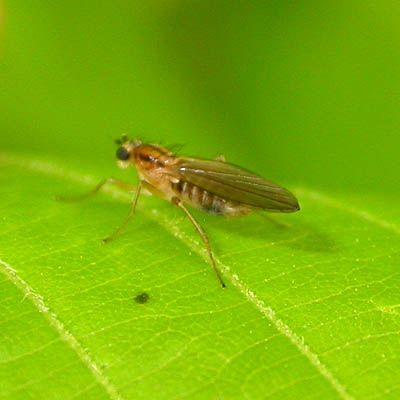Thread subject: Diptera.info :: Images from Japan from May 2005 10
Posted by Xespok on 28-07-2005 15:44
#1
This is a complete mystery to me. Maybe Agromyzidae or Chloropidae?

Posted by Paul Beuk on 28-07-2005 21:08
#2
Hmm, strongly reminds me of Lonchopteridae. Jan Willem?
Posted by Louis Boumans on 28-07-2005 22:13
#3
It looks a lot like
Lonchoptera, probably
lutea. Even though the wing venation and the bristles on the head are not very clear on this picture.
Btw, I never managed to find any other species of Lonchopteridae than the abundant
L. lutea and
L. bifurcata. Where are those other guys hiding?
Best wishes, Louis
Posted by Paul Beuk on 29-07-2005 08:48
#4
Louis Boumans wrote:
It looks a lot like Lonchoptera, probably lutea. Even though the wing venation and the bristles on the head are not very clear on this picture.
Remember, this one is from Japan, so there may be a whole range of other species...
Btw, I never managed to find any other species of Lonchopteridae than the abundant L. lutea and L. bifurcata. Where are those other guys hiding?
Most can be found in grassy vegetations though I know a few a mostly found on shingle banks. Jan Willem probably can tell more.
Edited by Paul Beuk on 30-07-2005 09:27
Posted by Jan Willem on 29-07-2005 21:34
#5
I wouldn't put my money on
Lonchoptera lutea. It won't be easy to identify the species after this picture! And Paul is right, there are several other species of Lonchopteridae occurring in Japan that are not found in Europe.
Louis, I can tell you that in 1990 we (i.e. the Insect Working Group in Tilburg) collected 5 species of Lonchopteridae (
L. bifurcata,
L. fallax,
L. lutea,
L. nitidifrons, and
L. scutellata) by means of a malaise trap, all in the same area, so keep looking, you might get lucky someday. But I have to admit that at other locations I also found
L. lutea (most abundant) and
L. bifurcata only.
Jan Willem
Posted by Xespok on 30-07-2005 11:16
#6
Thx for the ID. This fly really looked quite different from the others that I see, that is why I posted this despite the lowere quality of the image.
I'll stay with Lonchoptera sp. Anyway this is my first Lonchopteridae image in my gallery.
Xespok
Posted by Kahis on 02-08-2005 20:46
#7
I was also 'in the not-so-exclusive lutea/bifurcata club' until I read this paper by C. M. Drake:
The distribution and habitat preferences of British Lonchopteridae. Entomol. Monthly Magazine 138(2002):121-132.
With it's help I soon found
meijerei and
nigrociliata (on riverside shingle in sheltered locations). I've also caught
scutellata once in a Malaise trap and once by net, both from fens (the malaise was in a reed bed).
L. fallax in common in northern Finland and can there be easily found on wet riverside meadows.
Jere

